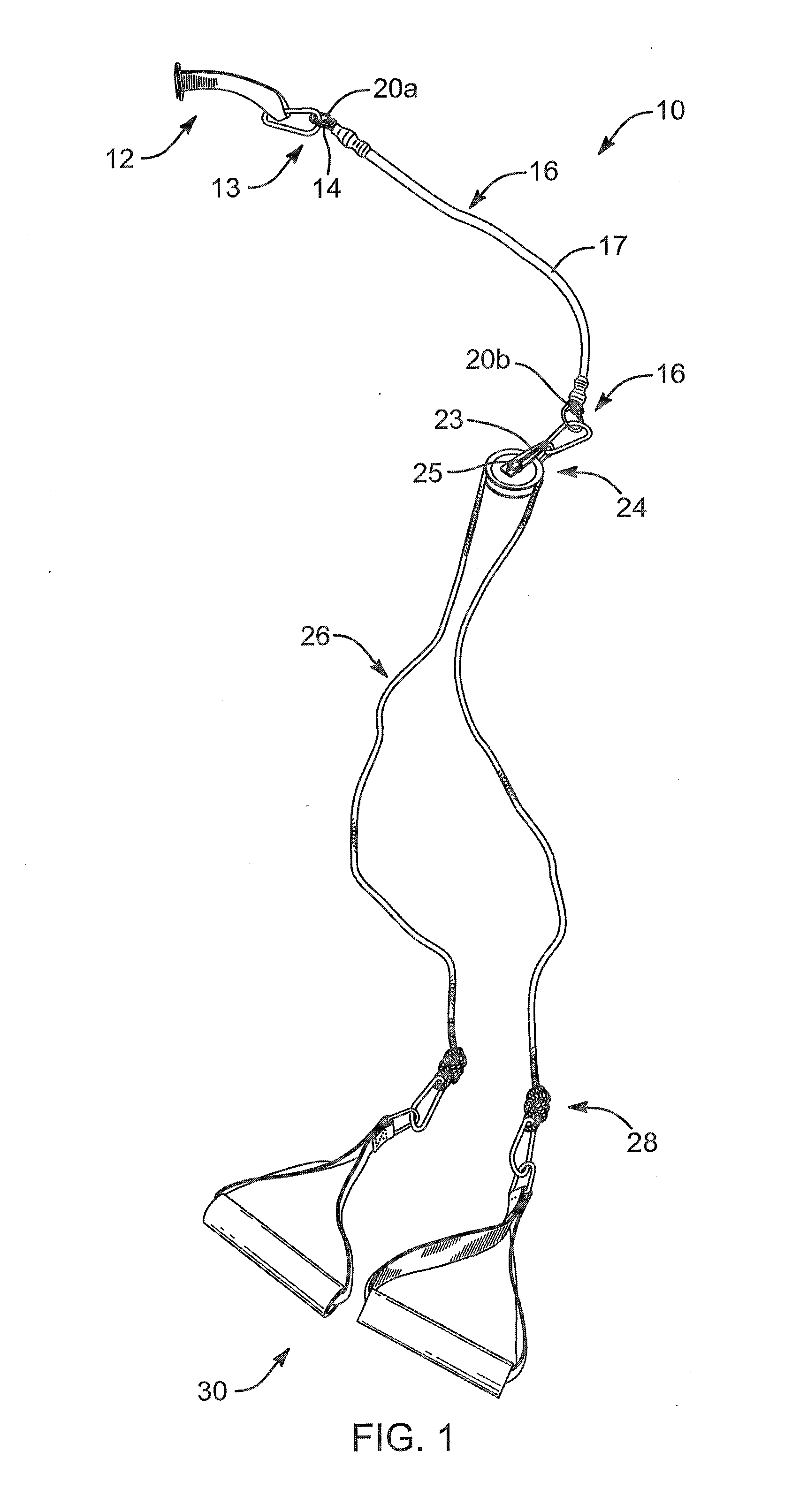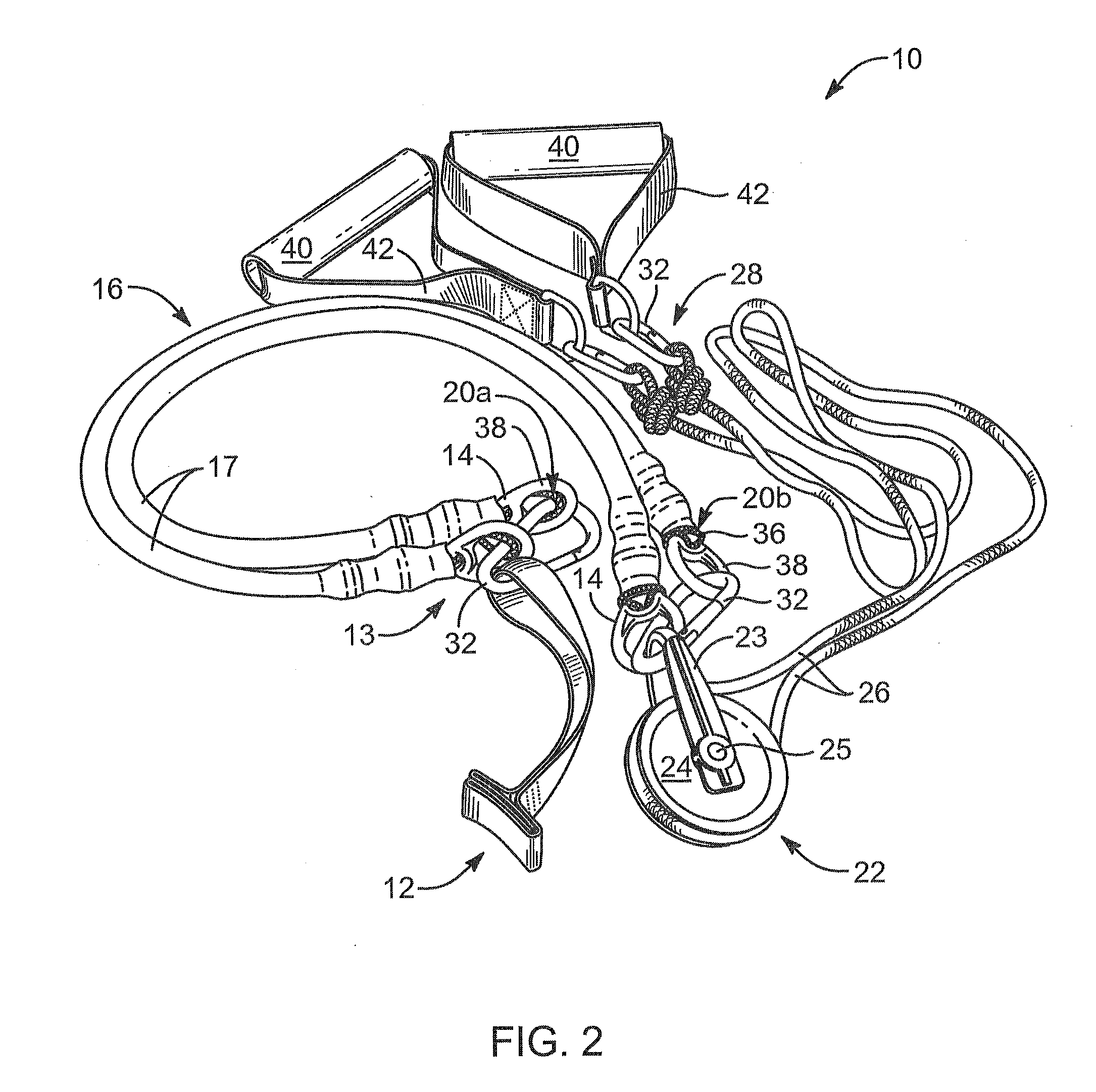Assisted-resistance-control, free-form, exercise apparatus and method
a technology of resistance resistance and free-form exercise, applied in the field of exercise equipment, can solve the problems of inefficiency or potential danger of both force characteristics for fitness or rehabilitation training, and the inability to meet the needs of rehabilitation exercise, and achieve the effect of safe and efficient exercise, wide range of motion, and high portability
- Summary
- Abstract
- Description
- Claims
- Application Information
AI Technical Summary
Benefits of technology
Problems solved by technology
Method used
Image
Examples
example 1
[0114]Shoulder PNF (Proprioceptive Neuromuscular Facilitation) Direction 1—Extension is exemplified in FIGS. 18A, 18B, and 18C. A user starts with the anchor 12 secured at a high position, the users side is to the pulley assembly 22, feet shoulder width apart, standing at a distance sufficient to create initial pre-stretch of excursion member 16 of at least 25%. To start the exercise, the users hand on the side closest to the pulley grasps one handle 30 and holds it waist high at midline in front of body (anchor hand). The opposite hand (active hand) grasps the other handle 30 and is crossed in front of body and extended fully upward.
[0115]The movement requires the user to keep the active arm elbow locked and rotate torso and shoulder away from pulley 22 with the active hand passing in front of the body and then down. This transverse movement requires an ascending-descending strength curve to have adequate resistance during the initial phase of the movement (ascending) and then redu...
example 2
[0117]Front squat, overhead press, lever extension. Anchor 12 should be placed at a low height. User begins in a squat position with back to pulley, handles held in both hands, palms up over shoulder.
[0118]Exercise movement is to take one step forward away from pulley while rising to a standing position. Once standing, the first arm is extended laterally to the side to a lever arm position. The second arm is then extended upward, both arms are held momentarily then returned to position above shoulders. The same movement pattern is then completed alternating hands to opposite side lateral extension and upward press. User strives to resist force pulling body back (lower back muscles) or twisting body to either side (core and obliques). If at any point the resistance on the lateral shoulder is too great, the upward hand may be released allowing it to drop back and reducing resistance (ARC). Both hands are then brought back to shoulders and user may step back dropping into squat.
[0119]T...
example 3
[0120]Swinging arm torso twist with bicep curl. Anchor 12 should be placed at mid height. User begins by facing the pulley 22 with feet together; grasping each handle 30 with both arms shoulder high and extended directly in front. Elbows may be locked with palms facing.
[0121]Exercise movement begins by extending the first arm laterally (keep elbows locked and shoulder high), rotating torso while continuing to swing arm back until 180 degrees from pulley. User should hold that position momentarily and with second arm, complete a bicep curl, hold then release the bicep curl allowing second arm to return to start position. Using eccentric contraction, slowly allow the first arm to return to starting position while simultaneously extending the second arm laterally to side until torso is rotated and second arm is 180 degrees from pulley. Perform bicep curl with first arm and release. Repeat lateral arm swing with first arm while using eccentric contraction of the second arm as it returns...
PUM
 Login to View More
Login to View More Abstract
Description
Claims
Application Information
 Login to View More
Login to View More - R&D
- Intellectual Property
- Life Sciences
- Materials
- Tech Scout
- Unparalleled Data Quality
- Higher Quality Content
- 60% Fewer Hallucinations
Browse by: Latest US Patents, China's latest patents, Technical Efficacy Thesaurus, Application Domain, Technology Topic, Popular Technical Reports.
© 2025 PatSnap. All rights reserved.Legal|Privacy policy|Modern Slavery Act Transparency Statement|Sitemap|About US| Contact US: help@patsnap.com



